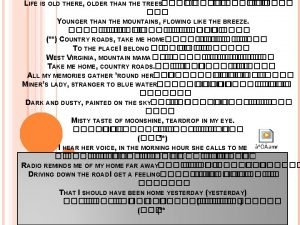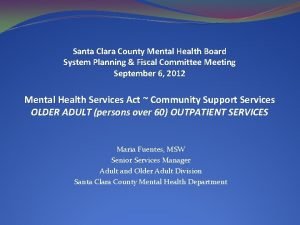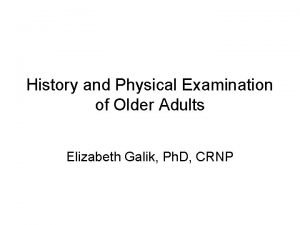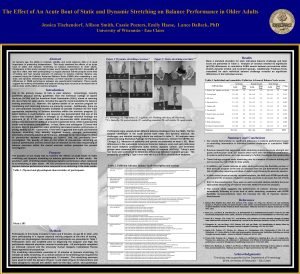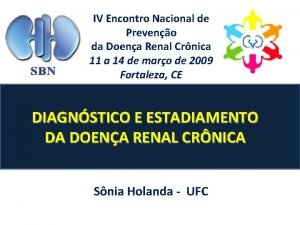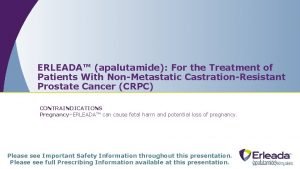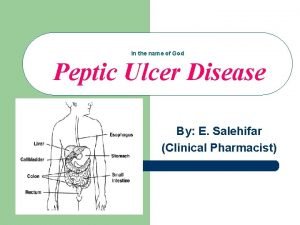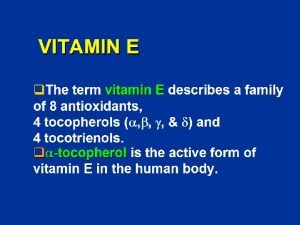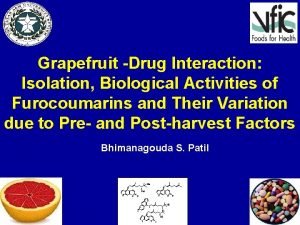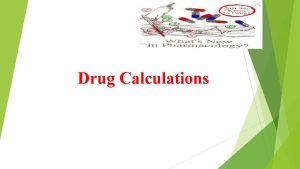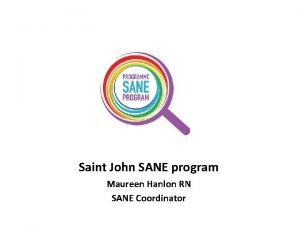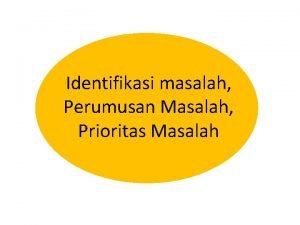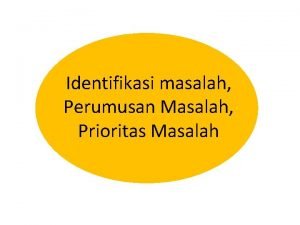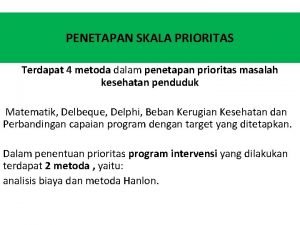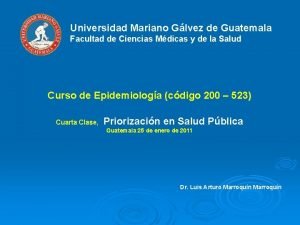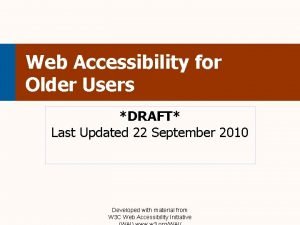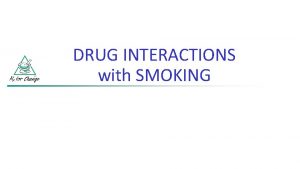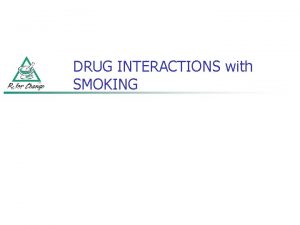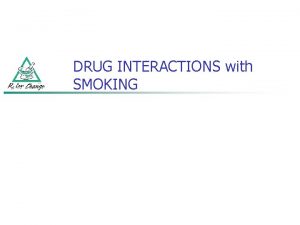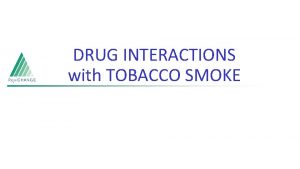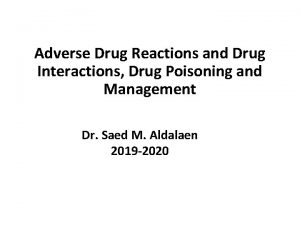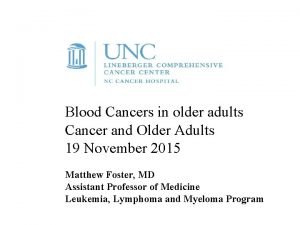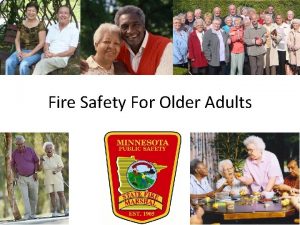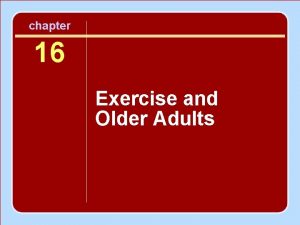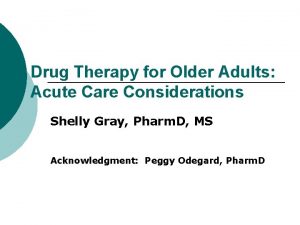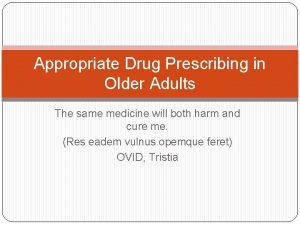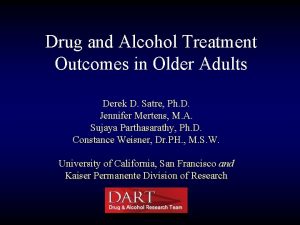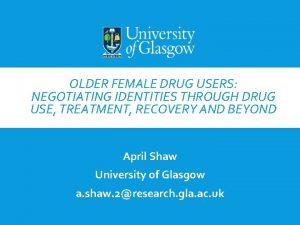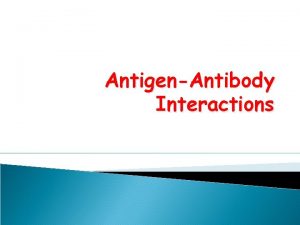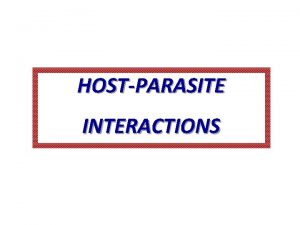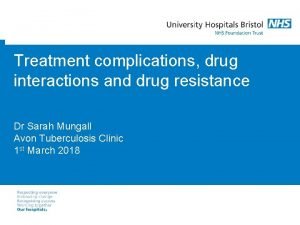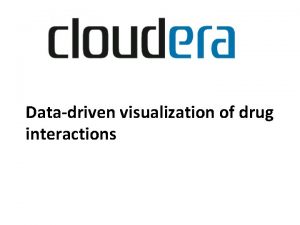Drug Interactions in Older Adults Joseph T Hanlon

































- Slides: 33

Drug Interactions in Older Adults Joseph T. Hanlon, Pharm. D, MS

Learning Objectives At the conclusion of this talk the participant should be able to: • List the 4 major types of drug interactions that can occur in the elderly • Discuss the epidemiology of the different types of drug interactions in the elderly • Implement strategies to prevent/manage drug interactions in the elderly

Types of Drug Interactions 1. 2. 3. 4. Drug-Drug Pharmacokinetic Drug-Drug Pharmacodynamic Drug-Food/Nutrient Drug-Disease

Drug-Drug Interactions Affecting Absorption and Distribution Precipitant Drug(s) Antacids, Iron Chloral hydrate • Object Drug(s) Outcome Tetracycline, Ciprofloxacin abs. Warfarin PPB Generally absorption and distribution drug-druginteractions are not clinically important. Drugs & Aging 1998; 12: 485 -94

Hepatic Metabolism Phase I (CYP 450) • Oxidation hydroxylation dealkylation sulfoxidation • Reduction • Hydrolysis Phase II • Conjugation glucuronidation sulfation glycine acetylation

Cytochrome P 450 Phase I Isoenzymes, % Total and Substrate Examples Isoenzymes CYP 1 A 2 CYP 2 C 9/19 CYP 2 D 6 CYP 2 E 1 CYP 3 A 4 % 17 26 2 -4 9 -10 35 -45 Substrate Olanzapine, Theophylline Phenytoin, Warfarin Codeine, Desipramine, Tramadol Chlorzoxazone, Ethanol Diazepam, Triazolam, Quinidine, Methadone, Carbamazepine www. drug-interactions. com

Inhibitors of Hepatic Cytochrome P 450 1 A 2 Fluvoxamine Cimetidine Ciprofloxacin 2 C 9/19 Amiodarone Fluconazole Fluvastatin Fluoxetine Isoniazid Sertraline Omeprazole Cimetidine 2 D 6 Fluoxetine Paroxetine Quinidine Ritonavir Bupropion Cimetidine www. drug-interactions. com 3 A 4 Erythromycin Azole antifungal Nefazodone Clarithromycin Ritonavir Cimetidine

Effect of Age on Theophylline Hepatic Metabolism Inhibition J Pharmacol Exp Ther 1997; 280: 627 -37.

Drugs That Interact with Theophylline • • Inhibitors Cimetidine Propafenone Mexiletine Propranolol Erythromycin Ciprofloxacin Fluvoxamine Drugs Aging. 2003; 20: 71 -84 • • • Inducers Barbiturates Phenytoin Smoking Rifampin Carbamazepine JAPHA 2004; 44: 142 -51

Drug-Drug Interactions With Warfarin Interacting Drug Aspirin Barbiturate Cimetidine Dipyridamole Fibrates Fluvoxamine Macrolides Phenytoin Quinolones Rifampin Sulfinpyrazone Thyroid hormones Ticlopidine Mechanism PD PK PK PD PD PK PK PK/PD PD PD Anticoagulant Effect N Engl J Med. 2003; 14; 349: 675 -83; JAPHA 2004; 44: 142 -51

Clinically Significant Drug-Drug Interactions with AEDs Object Drug Carbamazepine Carbamazepine Phenytoin Phenytoin Interacting Drug Danazol Diltiazem Macrolides Propoxyphene Verapamil Amiodarone Cimetidine Fluoxetine INH Omeprazole Outcome CBZ level CBZ level DPH level DPH level Neuropharmacology 2002; 5: 280 -9

Inducers of Hepatic Cytochrome P 450 1 A 2 Smoking Omeprazole Phenytoin 2 C 9/19 2 D 6 Rifampin None Phenobarbital Phenytoin www. drug-interactions. com 3 A 4 Carbamazepine Phenytoin Phenobarbital Rifampin St. John’s wort

Effect of Age on Theophylline Hepatic Metabolism Induction by DPH Crowley J. J Phamacol Exp Ther 1988; 245: 513 -23.

Selected Phenytoin Induction Interactions Object Drug Interacting Drug Methadone Quinidine Theophylline Warfarin Phenytoin CYP Isoenzyme Induced 3 A 4 1 A 2 2 C 9 Neuropharmacology 2002; 5: 280 -9.

Selected Drugs Secreted by Renal Tubules Basic (cationic) Agents • Amiodarone • Cimetidine • Digoxin • Procainamide • Quinidine • Ranitidine • Trimethoprim • Verapamil Acidic (Anionic) Agents • Cephalosporins • Indomethacin • Methotrexate • Penicillins • Probenecid • Salicylates • Thiazides

Drug-Drug Interactions With Digoxin Interacting Drug Amiodarone Clarithromycin Propafenone Quinidine Verapamil Effect on Levels Drug Saf. 2000; 23: 509 -32; JAPHA 2004; 44: 142 -51

Drugs that Interact with Lithium • Diuretics • ACE-I • NSAIDs

Pharmacokinetics Dosage Regimen Plasma Concen tration Pharmacodynamics Site of Action Effects

Drug-Drug PD Interactions Object Drug ACE-I Beta blockers Digoxin MAOI Meperidine Hydroxyine Interacting Drug (s) K+ & K+ sparing diuretics Verapamil Diuretics SSRI, Dextromethorphan, Pseudoephedrine, Anorexiants MAOI Thioridazine

Drug- TCA PD Interactions • Concurrent use with any other drugs with antimuscarinic properties • Concurrent MAOI • Type I antiarrhythmics • Clonidine • Guanadrel • Guanethidine

Drug-NSAID PD Interactions Object Drug Antihypertensives Corticosteroids Diuretics Triamterene Warfarin Interacting Drug NSAIDs Indomethacin NSAIDs Outcome BP risk of PUD diuretic effect K+ anticoagulant effect

CNS Polypharmacy and Falls in Elderly Persons Weiner D, et al. Gerontol 1998; 44: 217 -21

Drug-Food/Nutrient Interactions Drug Effect Phenytoin ↓ Folate Isoniazid ↓ Vit B 6 Phenytoin ↓ Absorption with NG feedings Levodopa High protein meals effect bloodbrain transport Altered taste sensation Captopril

Clinically Significant Drug –St. John Wort Interactions Object Drug Antidepressants Cyclosporine Digoxin Estrogen Indinavir Methadone Tacrolimus Theophylline Warfarin Outcome serotonergic syndrome levels, transplant rejection digoxin levels breakthrough bleeding indinavir levels withdrawal sx’s levels theophylline levels INR CPT 2004; 75: 1 -12

Other Clinically Significant Herb- Drug Interactions Object Drug Interacting Drug Anticonvulsants Digoxin Saquinavir Warfarin Warfarin Wormwood Gingko biloba Hawthorne Garlic Feverfew Garlic Ginger Ginkgo Ginseng Lancet 2000; 355: 134 -8. Outcome seizure threshold digoxin activity saquinavir levels risk of bleeding anticoagulant

Clinically Important Drug-Disease Interactions Determined by Expert Panel Consensus Drug Disease – – – – Anticholinergics Antiarrhythmics (Type 1 A) Amphetamines Aspirin Atypical antipsychotics Barbiturates Benzodiazepines Beta-blockers CCB 1 st generation Chlorpromazine Clozapine Corticosteroids Decongestants Digoxin BPH, constipation, dementia CHF (systolic dysfunction) HTN, insomnia PUD DM Depression COPD, dementia, falls COPD, DM, syncope CHF (systolic dysfunction) Postural hypotension, seizures Seizures DM, PUD Insomnia Heart block Lindblad C, Hanlon J et al. (abstract) J Am Geriatr Soc 2004; 52: S 135

Clinically Important Drug-Disease Interactions Determined by Expert Panel Consensus Drug – – – Metoclopramide Nitrofurantoin Non-aspirin NSAIDs Non-aspirin, non-COX II NSAIDs Opioid analgesics Sedative/hypnotics Skeletal muscle relaxants SSRIs Theophylline Thioridazine Thorazine Tricyclic antidepressants – Typical antipsychotics Disease Parkinson’s disease Chronic renal failure CRF, CHF, HTN PUD BPH, constipation, dementia Falls BPH Falls Insomnia Postural hypotension, seizures Seizures Arrhythmias, BPH, constipation dementia, falls, heart block postural hypotension Falls

Learning Objectives At the conclusion of this talk the participant should be able to: • List the 4 major types of drug interactions that can occur in the elderly • Discuss the epidemiology of the different types of drug interactions in the elderly • Implement strategies to prevent/manage drug interactions in the elderly

Epidemiology of Drug-Drug or Drug-Disease Interactions • • • Incidence of potential drug-drug interactions ranges from 217% of all Rx's and up to 6 -42% of elderly patients. Incidence of potentially clinically significant drug interactions is low in the elderly (usually must involve narrow therapeutic range drug and inhibitor/inducer of drug metabolism or renal excretion) There is evidence suggesting that adverse health outcomes associated with drug-drug interactions is infrequent. Drug-disease interactions occur in 6. 2 -40% of elderly patients Drug disease interactions may result in higher risk of adverse outcomes (e. g. , decline in functional status and increased health services use) due to alterations in homeostatic mechanisms and diminished functional reserve.

Drug Interactions Are Avoidable Previous adverse reactions Contraindicated drugs Drug interactions Totals Avoidable 7 57 67 131 Probably avoidable ---- 37 37 Uncertain ---- 3 29 32 7 60 133 200 Total Gosney et al. Lancet 1984; 2: 564

Strategies to Prevent/Manage Drug Interactions 1. Encourage patients to report all prescription, over-thecounter and complementary and alternative drugs at every health care encounter. 2. Support the implementation of electronic prescribing and/or the use by patients of one pharmacy with updated drug interaction software. 3. Work with pharmacists and be familiar with drug interaction information sources 4. Consider whether drug therapy is necessary 5. When adding a new drug to regimen, screen for potential drug-drug interactions.

Strategies to Prevent/Manage Drug Interactions 6. When adding a new drug to regimen in a patient, screen for potential drug-disease interaction. 7. If drug interaction can not be avoided, adjust doses and or/dosage intervals for affected medication and monitor the patient closely. 8. Carefully monitor other drug therapy when withdrawing a drug that can inhibit or induce hepatic metabolism. 9. Regularly review the need for chronic medicationsreduce polypharmacy

Learning Objectives At the conclusion of this talk the participant should be able to: • List the 4 major types of drug interactions that can occur in the elderly • Discuss the epidemiology of the different types of drug interactions in the elderly • Implement strategies to prevent/manage drug interactions in the elderly
 Life is older than the trees
Life is older than the trees Covids older adults
Covids older adults Altered cognition in older adults is commonly attributed to
Altered cognition in older adults is commonly attributed to Older adults mental health
Older adults mental health Conclusion of physical examination
Conclusion of physical examination Dynamic stretching for older adults
Dynamic stretching for older adults Mental health and older adults
Mental health and older adults Older adults
Older adults Mental health and older adults
Mental health and older adults Erleada mechanism of action
Erleada mechanism of action Ppi omeprazole
Ppi omeprazole Ppi drug interactions
Ppi drug interactions Vitamin e drug interactions
Vitamin e drug interactions Grapefruit-drug interactions chart
Grapefruit-drug interactions chart How to calculate drip rate
How to calculate drip rate Different methods of adulteration of crude drugs
Different methods of adulteration of crude drugs Financial accounting dyckman
Financial accounting dyckman Colette hanlon
Colette hanlon Metodo hanlon
Metodo hanlon Maureen hanlon
Maureen hanlon Tahap-tahap kegiatan dalamperubahan perilaku ( hanlon 1964)
Tahap-tahap kegiatan dalamperubahan perilaku ( hanlon 1964) Metodo de ranqueo
Metodo de ranqueo Delbeq
Delbeq Metode hanlon kualitatif
Metode hanlon kualitatif Skala prioritas masalah kesehatan
Skala prioritas masalah kesehatan Metodo de priorizacion de hanlon
Metodo de priorizacion de hanlon Delbeq
Delbeq Older women's cohousing
Older women's cohousing Which sentence tells you that hoa is older than nien
Which sentence tells you that hoa is older than nien The virtues of growing older
The virtues of growing older Bartosz older owl
Bartosz older owl Web accessibility for older users
Web accessibility for older users Which is older
Which is older Label
Label
